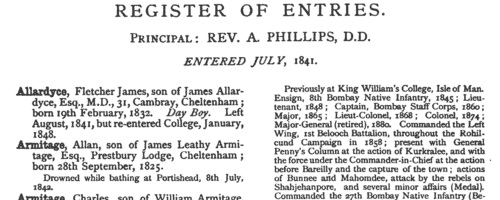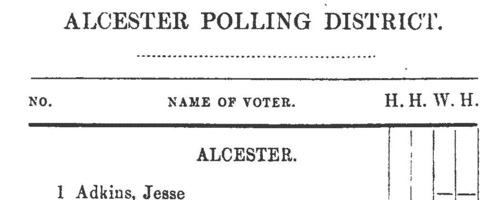Add this eBook to your basket to receive access to all 110 records. Our indexes include entries for the spelling scofield. In the period you have requested, we have the following 110 records (displaying 71 to 80): These sample scans are from the original record. You will get scans of the full pages or articles where the surname you searched for has been found. Your web browser may prevent the sample windows from opening; in this case please change your browser settings to allow pop-up windows from this site.  Inhabitants of Newington in Surrey
(1851) Inhabitants of Newington in Surrey
(1851)
The 1851 census return for St Mary Newington, Surrey, registration district: St Peter Walworth sub-district: enumeration district 12: described as: "All that Part of the Parish of St. Mary Newington, which Comprises The South Side of Providence St. from the School to Walworth Common, North side of Walworth Common to Burdett St., East side of Burdett St., East side of Ewhurst St. to Clandon St., Clandon St. from Ewhurst St. to Providence St. (both sides), Including Clandon Court, Clifford St. (both sides), Providence Place, Waterloo St. (both sides) and John St. (both sides) to Burdett St." This area lay in the ecclesiastical district of St Peter Walworth, and in the borough of Lambeth. HO 107/1567. The addresses listed in the actual returns are 1 to 4 and 7 to 9
Providence Street (including Lime Cottage); 5 and 6 South Street; 1 to 8 Gloucester Place; 1 to 6 Providence Place; 9 Hour Glass Lane; 1 to 16 Clifford Street; 1 to 19 Burdett Street; 1 to 13 and 19 to 22 and 101 Waterloo Street; The Village Maid beershop; 1 to 8 and 14 and 15 (Saint) John Street; 1 to 11 Ewhurst Street; and 1 to 13, 19 to 30 and 68 to 70 Clandon Street. | Sample scan, click to enlarge

|  Inhabitants of Newington in Surrey
(1851) Inhabitants of Newington in Surrey
(1851)
The 1851 census return for St Mary Newington, Surrey, registration district: St Peter Walworth sub-district: enumeration district 3: described as: "All that Part of the Parish of St. Mary Newington, which Comprises the West side of Walworth Road, from Walworth House to Walworth Gate, including The Toll House, Sutherland St. (both sides), the whole of Sutherland Square, and Terrace, Charlotte St., Charlotte Row, Princes Row, Graham St., Blucher St., Montpelier St. (East side), North side of Hill St. to Kettle's Place. Including Kettle's Place". HO 107/1567. This area lay in the ecclesiastical district of St Peter Walworth, and in the borough of Lambeth. The addresses listed in the actual returns are 1 to 6 Keens Row; 1 to 32 Sutherland Street; 1, 2 and 6 to 12 Sutherland Terrace; 1 to 17 Sutherland Square; 1 to 11 Walworth Place; 1 to 7 Charlotte Street; 1 and 2 Sutherland Cottages; 1 Sutherland Mews; 1 to 24 Charlotte Row; 1 to 13 Princes Row; Montpelier Tavern; Craigs Cottage; 1 to 13 Graham Street; 1 to 7 Blucher Street; 1 to 4 Montpelier Street; 1 to 14 Hill Street; 1 to 19 James Place; and 1 to 6 Kettles Place. | Sample scan, click to enlarge

|  Inhabitants of Newington in Surrey
(1851) Inhabitants of Newington in Surrey
(1851)
The 1851 census return for St Mary Newington, Surrey, registration district: St Peter Walworth sub-district: enumeration district 1: described as: "All that Part of the Parish of St. Mary Newington, which Comprises the West side of the Walworth Road, from West St. to Manor Place, the South side of Manor Place, East side of Canterbury Place, North side of West St., Lorrimore Terrace, Manor Terrace, Cottages in the Fields, Manor St., and South Terrace Lorrimore Road". This area lay in the ecclesiastical district of St Peter Walworth, and in the borough of Lambeth. The addresses listed in the actual returns are 1 to 13 Canterbury Place; 1 to 31 Manor Place (including Wooden Cottage and Warner Cottage); 1 to 28 Penton Row (including Manor Cottage, Walworth Road); 1 to 22 West Street; 1 to 15 Harford Place; 1 to 12 Lorrimore Terrace; 1 to 20 Manor Terrace; cottages on Lorrimore Common (including Lorrimore Cottage and Coates's Cottage); 1 to 6 Manor Road; and 1 to 10 South Terrace. HO 107/1567 | Sample scan, click to enlarge

| Boys entering Cheltenham College
(1853)
Cheltenham College 'was founded in order to provide for the sons of gentlemen a Classical, Mathematical, and General Education of the highest order, on moderate terms, in strict conformity with the principles and doctrines of the Church of England.'
Andrew Alexander Hunter, the college registrar, compiled the first edition of the College Register in four parts from 1883 to 1886: these merely listed the boys by term of entry, with their dates of birth and names and addresses of their fathers. Circulars were also sent out to all Old Cheltonians whose addresses were known, requesting additional details. On the basis of the returns from these and Hunter's further researches, this much fuller register was published in 1890.
The information after each boy's name is given (where known and applicable) in this format: father's full name and address as of the time the boy entered the college; class and department on entering the college (classes being number from 1 downwards, and these again divided into A and B, some into C and D, others into P (Principal's side) and V. P. (Vice-Principal's side) - 1A was the highest class in each department: besides this, certain others were called Addiscombe, Woolwich, Civil, Direct, Line, Sandhurst, Naval, Special, Preparatory, Latin, and India Civil) and the same on leaving, name of Boarding House (or 'Day Boy'), scholastic and athletic honours attained at the college, and subsequent career (including date and place of death, or present address in 1890, if known). | Sample scan, click to enlarge

| Insolvents
(1855)
Insolvency notices for England and Wales: insolvency often caused people to restart their lives elsewhere, so these are an important source for lost links | Sample scan, click to enlarge

| Insolvents
(1855)
Insolvency notices for England and Wales: insolvency often caused people to restart their lives elsewhere, so these are an important source for lost links | Sample scan, click to enlarge

|  London Policemen
(1843-1857) London Policemen
(1843-1857)
The Metropolitan Police Register of Joiners (MEPO 4/334) lists policemen joining the force 1 January 1843 to 1 April 1857 (warrant numbers 19893 to 35804). The register is alphabetical, in so far as the recruits are listed chronologically grouped under first letter of surname. It gives Date of Appointment, Name, Number of Warrant, Cause of Removal from Force (resigned, dismissed, promoted or died), and Date of Removal. Although the register was closed for new entrants at the end of 1842, the details of removals were always recorded, some being twenty or more years later. Those recruits not formerly in the police, the army, or some government department, were required to provide (normally) at least two letters of recommendation from persons of standing, and details of these are entered on the facing pages: the names in these are indexed separately - this index refers only to the police constables. Where a recruit was only recently arrived in the metropolis, the names and addresses of the recommenders can be invaluable for tracing where he came from. | Sample scan, click to enlarge

| Bankrupts in England and Wales
(1858)
Perry's Bankrupt and Insolvent Gazette, issued monthly, included lists of bankruptcies and stages in the liquidation of the estate, payment of dividends, and discharge. The initial entry in this sequence gives the name of the bankrupt (surname first, in capitals), the date gazetted, address and trade (often with the phrase dlr. and ch., meaning dealer and chapman); the dates and times and courts of the official processes of surrender; the surname of the official commissioner (Com.); the surname of the official assignee; and the names and addresses of the solicitors; the date of the fiat; and whether on the bankrupt's own petition, or at the demand of petitioning creditors, whose names, trades and addresses are given. In subsequent entries the bankrupt is often merely referred to by name and trade. This is the index to the names of the bankrupts, from the issues from January to December 1858, which may or may not include the detailed first entry for any particular individual. | Sample scan, click to enlarge

| Residents and Traders in Birmingham
(1861)
William Cornish's Corporation General and Trades Directory covered Birmingham, Coventry and the towns of the Black Country. The Birmingham section contains both street lists and this general alphabetical directory. | Sample scan, click to enlarge

| Electors for Leek Wootton
(1868)
A poll for the election of two knights of the shire to represent South Warwickshire was held 24 November 1868: the candidates were Lord Hyde (H.), Sir R. N. C. Hamilton (H.), H. C. Wise, Esq. (W.) and John Hardy, Esq. (H.). This poll book lists all those electors who voted; the county franchise included not only male freeholders of 40s a year, but also £10 copyholders and long-leaseholders, and £50 short-leaseholders and tenants. In addition, where no vote was cast the elector's number and name are given, the name in italics. The names are arranged by polling district and then by parish or township. Freeholders holding requisite property in a district are listed there, but might well reside elsewhere. The right-hand column indicates how each man voted. | Sample scan, click to enlarge

|
Research your ancestry, family history, genealogy and one-name study by direct access to original records and archives indexed by surname.
|












